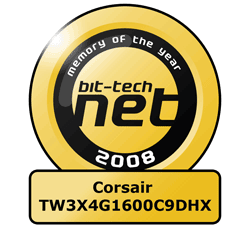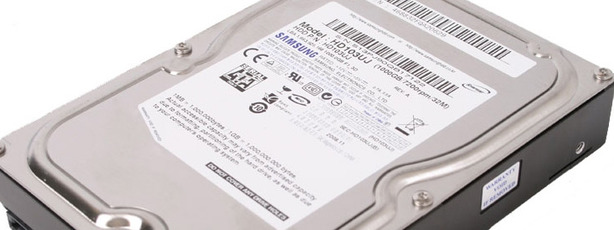
Best Memory Product: Corsair TW3X4G1600C9DHX
Notable Mentions: OCZ DDR2 PC2-9200 Flex II 4GB Series, G.Skill Pi Black Series 4GB 800MHz.While we recognise not everyone wants DDR3 - Corsair's (non-EPP) 1,600MHz C9 4GB sticks overclocked fantastically for the very reasonable price.
Performance of memory that are twice the price is hard to ignore, and with Corsair's DHX heatsinks adding very cool running to its feature set means it has everything going for it.
That is, should you need DDR3. OCZ's FlexII brings both innovation and incredible performance to DDR2. At PC2-9600 there are very few, if any, 4GB kits that are faster and OCZ's memory can be air or watercooled.
At a very approachable price the only thing stopping this from beating the Corsair is the fact the watercooling side is limited and the heatsinks are too fat to be installed side by side - meaning 8GB of FlexII memory can't happen.

 Finally, G.Skill's 4GB 800MHz Pi Black modules are very cheap, afford better CAS-4 performance than the usual, slower CAS-5 and the heatspreaders look great; providing something a little different in a case. Most performance enthusiasts will want to opt for 1,066MHz DDR2, but 800MHz is still extremely popular for a cost effective upgrade.
Finally, G.Skill's 4GB 800MHz Pi Black modules are very cheap, afford better CAS-4 performance than the usual, slower CAS-5 and the heatspreaders look great; providing something a little different in a case. Most performance enthusiasts will want to opt for 1,066MHz DDR2, but 800MHz is still extremely popular for a cost effective upgrade.Best Storage Product: Samsung SpinPoint F1 1TB
Notable Mention: Intel X25-M 80GB SSDWe’ve only recently started looking at storage products in a lot more detail than we have before, but even then there have been some big moves in this sector of the industry in 2008. Because of this, we felt it was necessary to reward those products that have really impressed us in world of storage.
The biggest of these has arguably been the explosive arrival of solid state technology from all corners of the industry – even Intel has joined the act – and there is a lot of buzz about SSDs being the future of storage. While that may be the case, the technology is far from mature right now and it’s not going to replace traditional mechanical drives just yet.

In fact, out of all the SSDs we’ve seen, there has really only been one that had a few of us reaching for our wallets. Intel’s X25-M 80GB solid state drive not only delivered blistering read speeds, but also respectable write speeds as well – it’s in a different league to any other MLC-based drive on the market today.

You could argue that Intel’s X25-E 32GB SSD is faster, but we found some rather bizarre inconsistencies in performance that were related to the SLC technology it is based on.
While the technology delivers blisteringly fast write speeds the first time a formatted drive is written to, SLC only modulates between two states – written and unwritten – meaning that re-writing to a cell which has already been written to requires the cell’s state to change from written to unwritten before the write can proceed. This results in some inconsistent write performance which, at worst, can halve performance, making the drive less attractive for those looking for the best performing drive on the market.
Outside of the SSD world, there was one product in particular that has impressed us ever since it was first released in February – even though we didn’t get around to reviewing it until December. That was, of course, Samsung’s SpinPoint F1 1TB hard drive.
Combining excellent class-leading performance and a massive amount of space with an affordable price point makes the SpinPoint F1 1TB seem almost too good to be true. It’s not, though, and it makes a fantastic boot drive at just seven pence per GB.

MSI MPG Velox 100R Chassis Review
October 14 2021 | 15:04








Want to comment? Please log in.